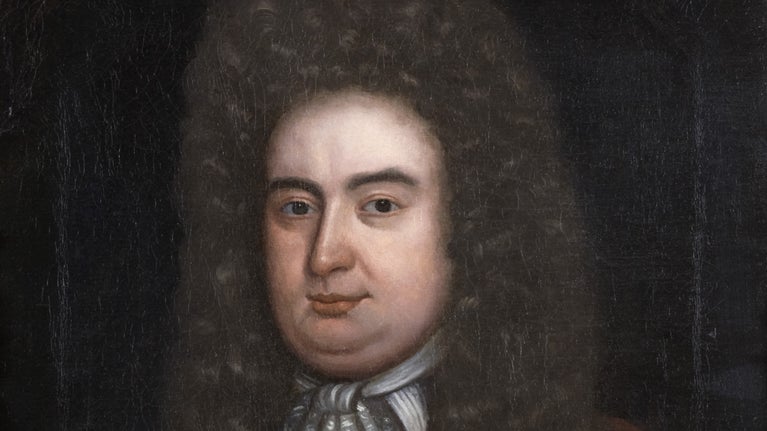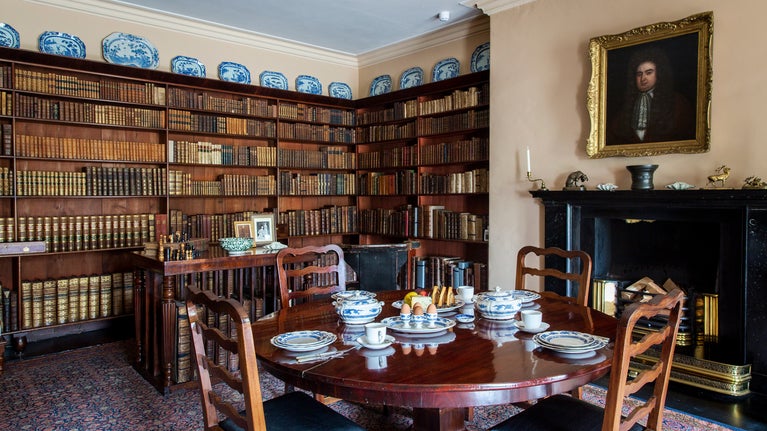
Discover more at Springhill
Find out when Springhill is open, how to get here, things to see and do and more.

Built in the late 1600s, Springhill is a rare surviving example of a Plantation-era house in Ulster. For over 250 years, it was home to ten generations of the Conyngham and Lenox-Conyngham family. From its Plantation origins and the Williamite Wars, through Georgian refinement and wartime requisition, to the writings of Mina Lenox-Conyngham in the twentieth century, Springhill tells a layered story of continuity and change.
Springhill stands in the former territory of the O’Lynns, Gaelic rulers of the minor kingdom of Uí Tuirtre. This was once a pastoral landscape dotted with raths (ringforts), one of which survives in the demesne. By the sixteenth century, it formed part of the dense forests of Glenconkeyne and Killetra, home to wolves and a refuge for displaced Irish during the Nine Years’ War (1594–1603). These woodlands were later cleared for colonial settlement.
Following the Flight of the Earls in 1607, when leading Gaelic lords left Ireland after defeat by the English Crown, large tracts of land in Ulster were confiscated and redistributed to British settlers. County Londonderry was extensively reshaped by the Plantation, overseen by The Honourable The Irish Society, a body of London trade guilds tasked with establishing towns, roads, and agricultural settlements.
By the mid-1600s, the land at Ballindrum (now Springhill) was held by William Conyngham (d. 1666), a Scottish settler. His son, William ‘Good Will’ Conyngham (d. 1721), inherited the estate in 1666. In 1680, he married Anne Upton of Castle Upton and undertook to build a new house “of lime and stone, two storeys high.” Dendrochronology, or tree-ring dating, of the roof timbers revealed the house was constructed in the 1690s.

Good Will held considerable local influence. As Overseer of the Woods and Forests of Ulster, he helped clear woodlands for settlement and agriculture. He also served during the Williamite Wars; his commission, signed by King William III, survives in Springhill’s collection.
In 1689, during the Siege of Derry, Good Will joined other Protestant leaders in refusing Jacobite forces entry into the walled city. The successful defence became a defining moment in Ulster Protestant history.
On Good Will’s death in 1721, the house passed to his nephew, George Butle Conyngham (d. 1765), Deputy Governor of Londonderry and founder of the nearby market town of Coagh. His 1722 estate map shows tree-lined avenues at Springhill and axial planning still visible today.
Colonel William Conyngham (1723–84), a veteran of the Seven Years’ War, extended the house with a new Drawing Room, dovecote and service buildings. His marriage to Jean Hamilton in 1775 brought a dowry that eased debts and funded improvements. He also raised the local Volunteers, later merged into the Springhill Union corps.
The estate passed to George Lenox-Conyngham (1752–1816), a key figure in the Springhill Union and the Londonderry Militia. He opposed the Act of Union, as letters in the archive reveal.
His son, William ‘Wims’ Lenox-Conyngham (1792–1858), trained for law before returning to manage the estate. He married Charlotte Staples of nearby Lissan House and made architectural additions including a new Dining Room, recorded alongside estate accounts that detail operations and staffing.
A new chapter began in 1856 when Wims’s son, Sir William Fitzwilliam Lenox-Conyngham (1824–1906), married Laura Arbuthnot, daughter of a wealthy banking family. Agricultural buildings were upgraded, extensive planting took place, and at its peak the estate covered over 900 acres. Sir William commanded the County Derry Militia for 35 years and was later knighted for his service.
Like many Irish landed estates, Springhill was affected by the Land Wars of the late nineteenth century, when tenant farmers united to demand fair rents and the right to stay on their land. A series of Land Acts followed, allowing many tenants to buy their farms from landlords. At Springhill this meant rent reductions, land sales and timber felling for income. The family moved temporarily to England during this period, but despite these challenges, they returned to Springhill and remained resident into the 20th century.

During the Second World War, Springhill was requisitioned by the US Army. Nissen huts were erected on Tower Hill, while the main house, outbuildings, and courtyards were used for officer accommodation, recreation, and drills.
Mina Lenox-Conyngham (1867–1961), then lady of the house, initially found the occupation unsettling, but soon embraced her role as host. She created a lending library for the troops, covering books in brown paper, many of which survive. Her writings recall the bustle of soldiers, interdenominational services, and German prisoners of war carrying out repairs on the grounds.
Mina was a writer, historian, and community advocate. Her book, Springhill: An Old Ulster House, blends memoir and research, offering insight into the house and its occupants. In 1957, her son Captain William Lowry Lenox-Conyngham (1903–1957) transferred Springhill to the National Trust. Mina remained until her death in 1961.
Springhill’s collection reflects generations of use, inheritance, and adaptation rather than focused collecting. Many items were brought by women marrying into the family, including pieces from nearby Lissan House.
The Library is one of the most important domestic libraries in Northern Ireland, holding volumes on theology, law, agriculture, politics, and travel, often annotated with the family’s own thoughts. Some belonged to Lady Blessington and her goddaughter Harriet Molesworth, reflecting a lineage of scholarly women.
The painting collection includes provincial portraits and works by William Hoare of Bath, Hugh Douglas Hamilton, and the studio of Pompeo Batoni. Two portraits of King William III and Queen Mary reflect the family’s political allegiances.
Springhill also holds one of the National Trust’s most significant regional costume collections. It began with family garments preserved across generations and was later expanded by donations.
The Lenox-Conyngham papers, now held at the Public Record Office of Northern Ireland, form one of the richest family archives in the country.
Today, Springhill is valued not just for its architecture but for the depth of its collections and archives. Its library, costume collection and family papers preserve an unusually complete record of Ulster’s past, seen through the lives of one family across three centuries.

Find out when Springhill is open, how to get here, things to see and do and more.
Step back in history on a visit to Springhill, often referred to as 'one of the prettiest houses in Ulster'.

Part of the collection of historic textiles at Springhill House, the Court Mantua dress was made for attendance at court in the 1740s and made a special appearance at a royal ball.

Learn about people from the past, discover remarkable works of art and brush up on your knowledge of architecture and gardens.

Explore the objects and works of art we care for at Springhill on the National Trust Collections website.
